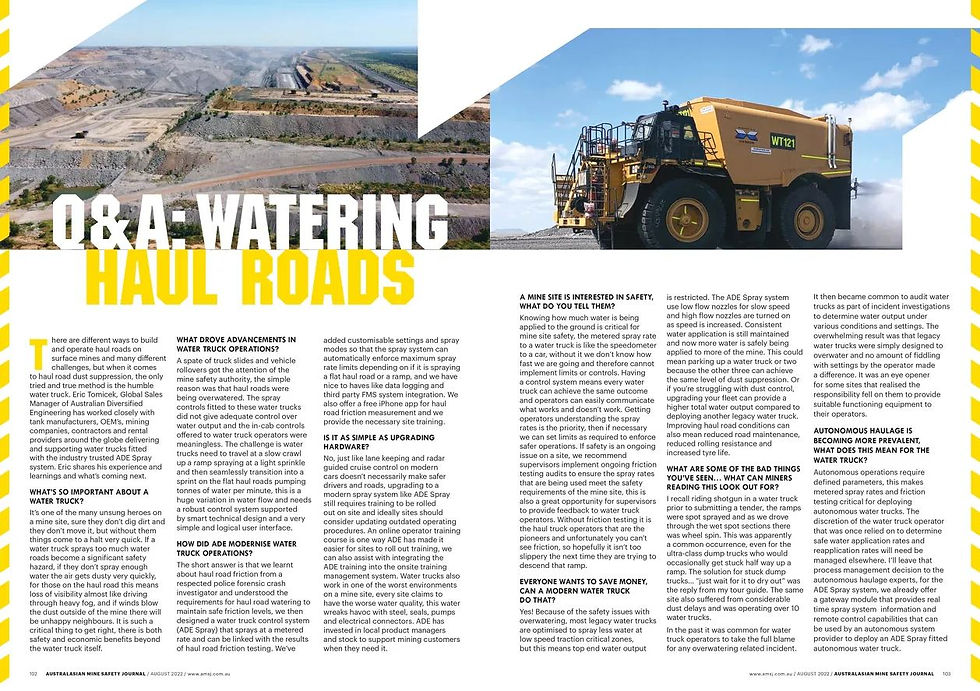Haul Road Hit List
- ADE

- Oct 21, 2022
- 3 min read
The METS sector is constantly innovating and developing new solutions that will make mining operations safer and more efficient. But it can certainly be difficult browsing the endless range of products and services and quickly determining if a solution offered would be beneficial to your mine site.
Australian Diversified Engineering(ADE) is one METS company that specialises in haul road operations and the humble water truck. Eric Tomicek, Global Sales Manager of ADE has put together the below questions and considerations to help you identify potential risks and improvement opportunities in your operations.

Road Watering
Water truck operations on the surface can seem a simple task, but a simple miscalculation causing overwatering of a haul road can result in a serious accident or high potential incident.
Are your water trucks fitted with simple and logical operator controls? A logical control system allows an operator to select a specific watering rate to be applied to the ground, it’s the difference between “driving slow” and “driving at 20 km/h”. Meaningless adjectives do not constitute clear instructions so it is important to be able to select defined and repeatable settings. Underwatering haul roads is also a concern for any mine site as it leads to increased dust emissions and can impact safety, equipment maintenance and the surrounding community.
Can your water truck sufficiently water haul roads when travelling over25 km/h? Have a quick look at the size of the water pump and spray head apertures, mine sites require a spray system that can lightly water roads at low speeds but can also increase water output sufficiently as ground speed increases which requires a robust control system. Unfortunately due to changing conditions and the potential for operator error, the risk of an incident is always present.
Does your spray system data log operator inputs and settings? Quality data aids investigation and helps us learn from mistakes so that we can implement better processes.
Do your supervisors measure haul road friction and is there a process in place to share friction testing results? Developing a process to support the decision making process of the water truck operator will result in consistent haul road conditions and confident haul road users driving productivity.
Emergency Response
A mining water truck is not an emergency response vehicle, but it may be relied upon as a first responder. Their place in the pit makes them the perfect candidate to quickly respond to a fire emergency and take control whilst ERT are in transit. Water trucks may be fitted with remote operated water cannons or rear facing deluge sprays which can be used depending on the type of fire emergency.
What is the actual flow rate and reach of your water cannon and does it comply with site requirements? All aspects need to be measured including the cannon nozzle, inlet diameter, supply pipe diameter and water pump configuration. If you are inducting foam into your water cannon nozzle to assist with fire suppression, have you verified the foam induction rate? Whilst the concept is to simply use a nozzle to induce chemical foam into the cannon nozzle from a tank, chemical foam manufacturers specify a specific rate at which the foam should be mixed. The hose and fittings between the nozzle and tank as well as the foam tank position in relation to the nozzle can all effect the mixing rate of the foam.
How big is your foam tank and is it sufficient? A typical CAT 777G water truck can spray water from the cannon for approximately 30 minutes. Atypical foam tank is approximately 500 litres and will empty in under 10 minutes. In the event of a tyre fire, a water truck may reverse up to the fire and spray water using rear facing nozzles.
Are your spray nozzles high enough to reach the top of a truck tyre and how close must the machines be for the sprays to be effective? Considering most water trucks are smaller than their haulage compatriots, it is very possible that your dedicated ‘tyre fire sprays’ may only be wetting the lower half of the tyre. If the throw distance is as low as 10 metres, there is a risk of the responding water truck also catching fire.

Mining is a journey of continuous improvement and we hope that these questions help you with your goals of improving safety and efficiency on your mine site. The goal is to encourage a conversation and at ADE, we are always excited by the opportunity to discuss your unique mining operation.
The Australian METS sector is a treasure trove of great ideas, products and new innovations. But sometimes new innovation requires an update to the Standard Operating Procedures to receive the full benefit.
Read More Here: www.amsj.com.au
Australasian Mine Safety Journal: April 2022 Edition





Comments